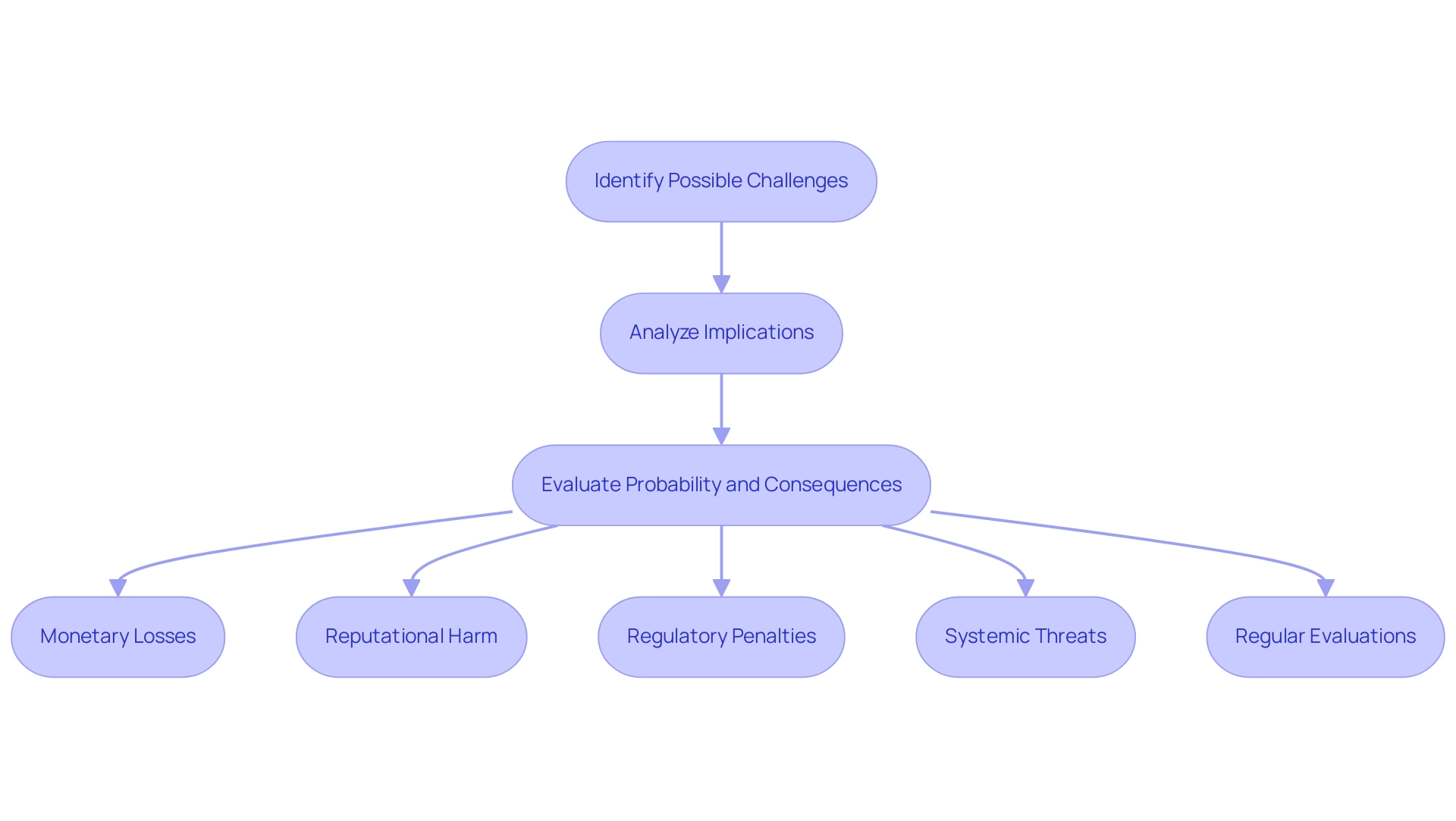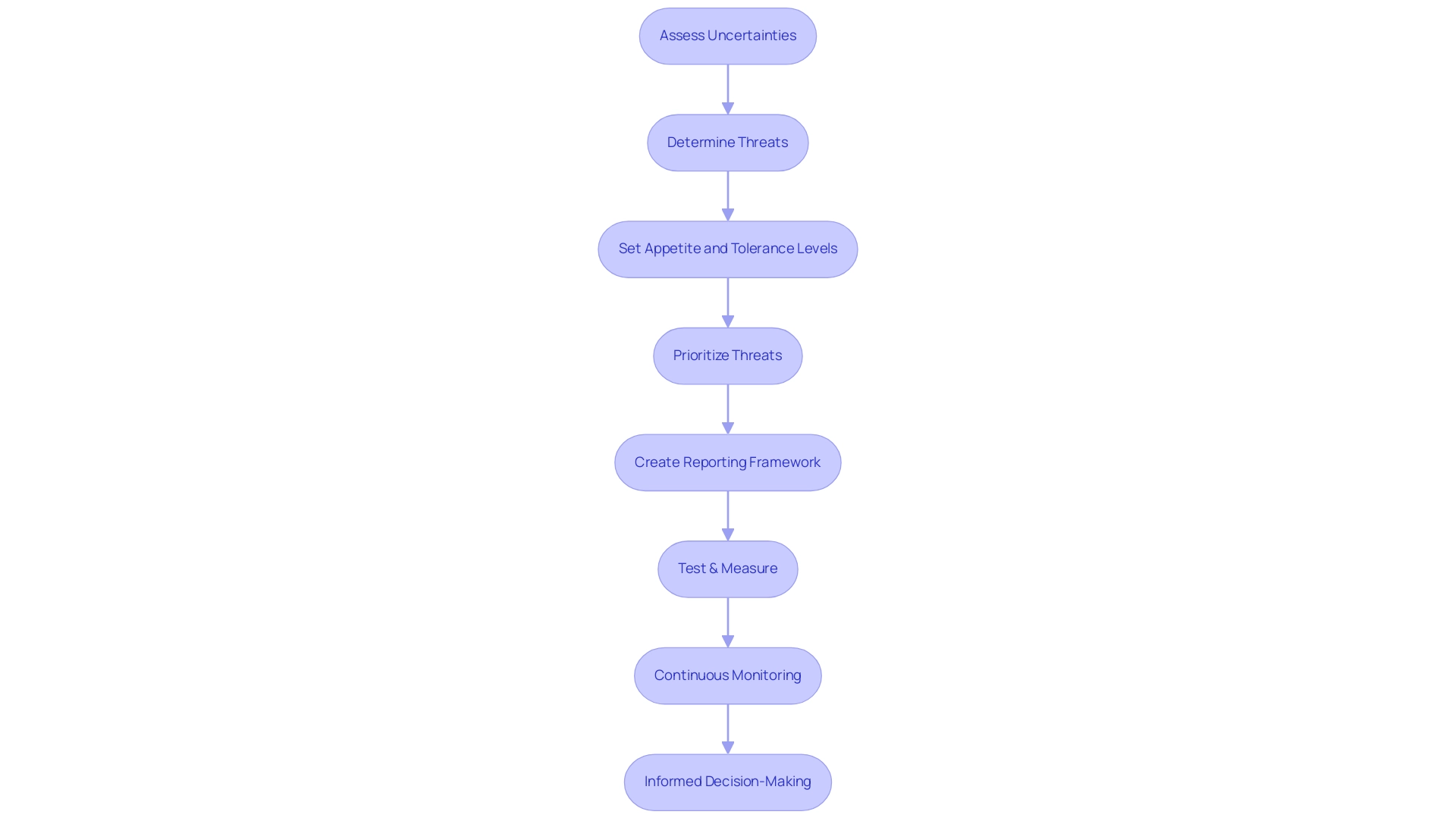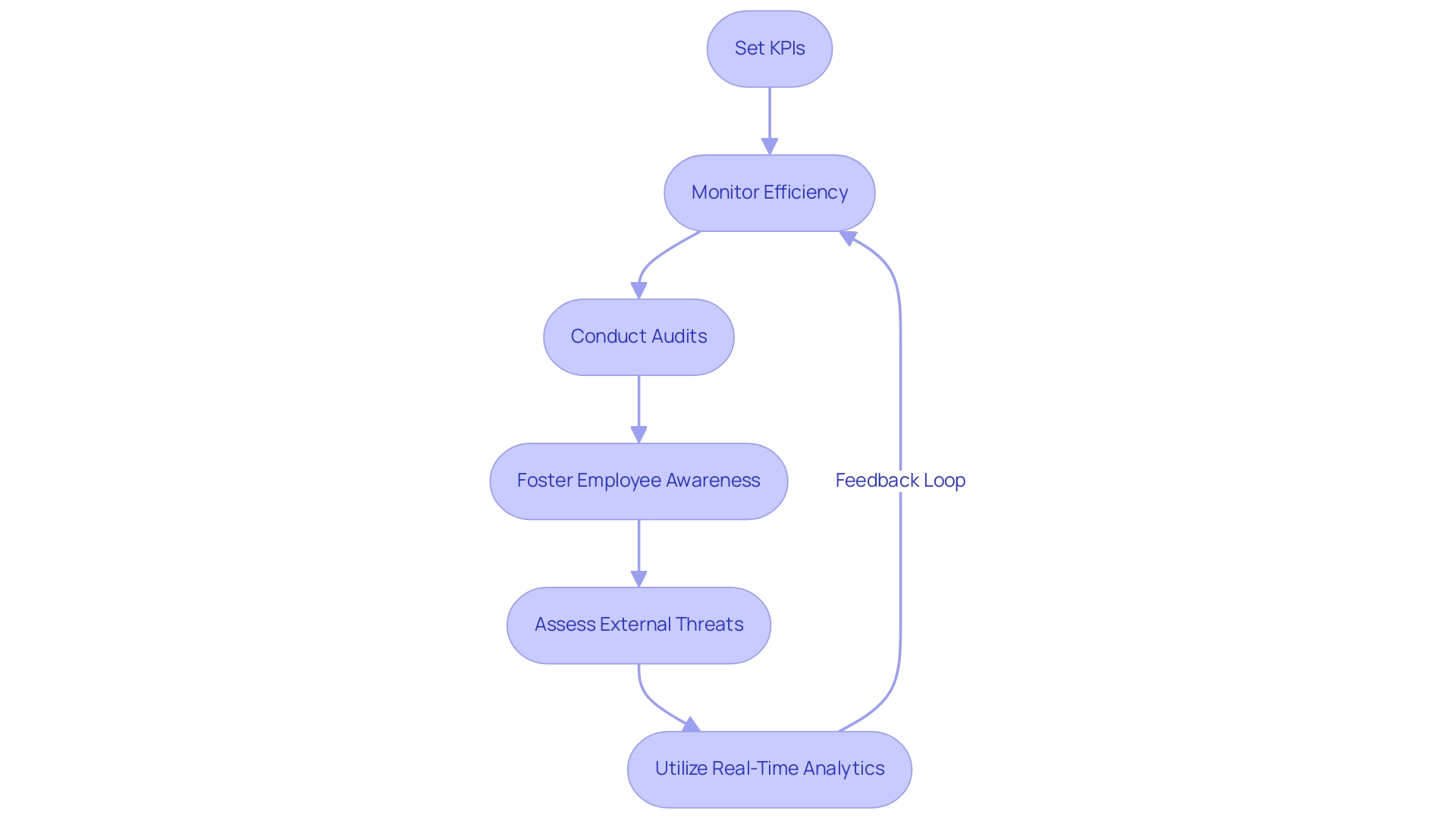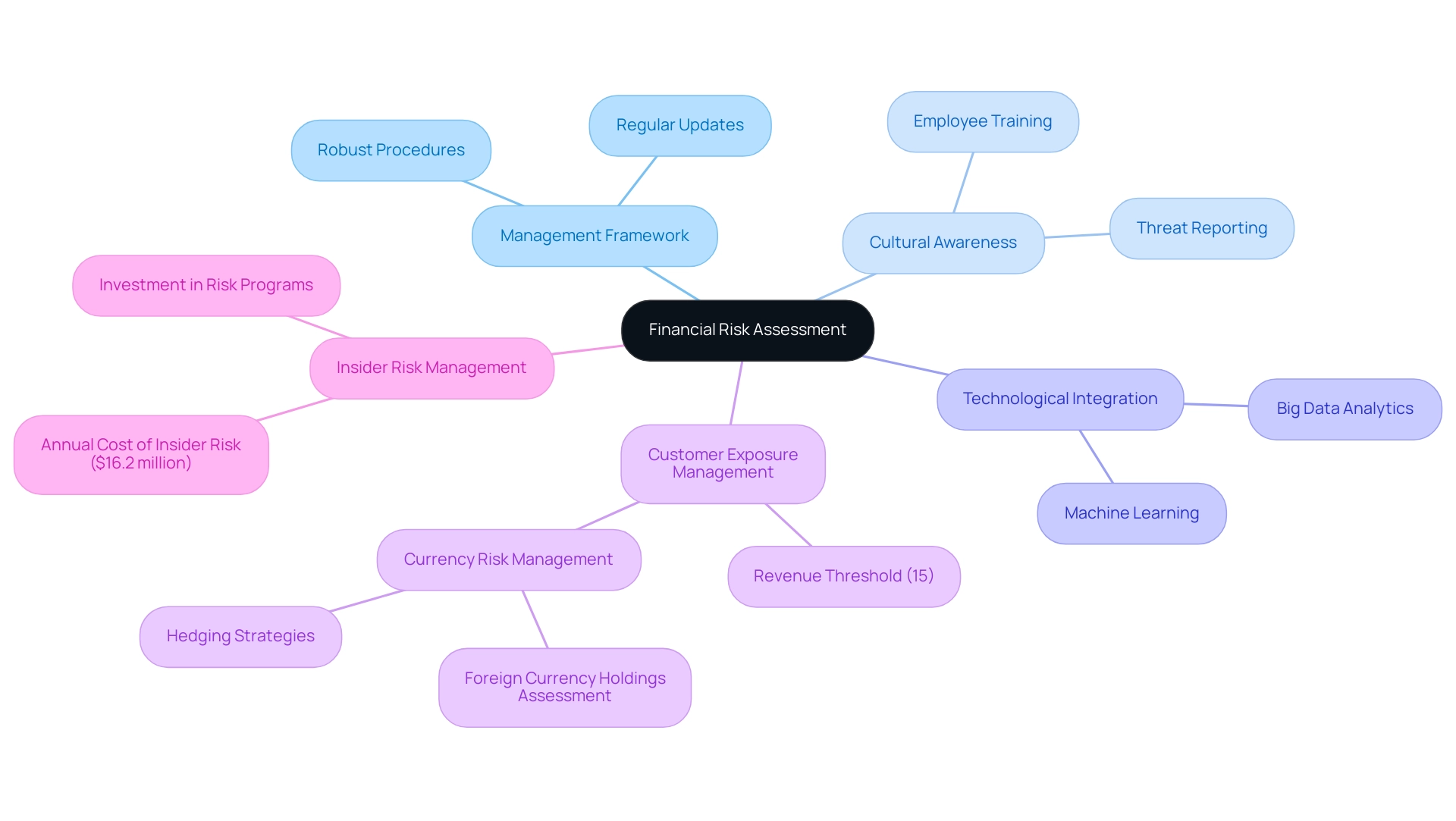Overview
To implement effective financial institution risk assessment procedures, organizations should follow a structured five-step approach: identifying, analyzing, assessing, treating, and monitoring risks. The article emphasizes that this systematic method not only enhances compliance with regulatory standards but also strengthens the institution's ability to navigate complex economic challenges, as evidenced by the increasing financial pressures and insider threat costs faced by organizations today.
Introduction
In the intricate world of finance, risk assessment emerges as a cornerstone for safeguarding institutions against potential threats that could jeopardize their stability. With the financial landscape evolving at an unprecedented pace, particularly in regions like Vietnam where corporate debt is projected to escalate significantly, the urgency for effective risk management has never been clearer.
This article delves into the multifaceted nature of risk assessment, exploring critical categories such as:
- Credit risks
- Market risks
- Operational risks
- Compliance risks
By examining essential steps in the risk management process, organizations can not only navigate regulatory complexities but also foster sustainable growth amidst uncertainty. As financial institutions confront challenges like rising household debt and insider threats, understanding and implementing robust risk frameworks becomes paramount in ensuring long-term viability in a rapidly changing economic environment.
Understanding Risk Assessment in Financial Institutions
The financial institution risk assessment procedures are a critical process that entails identifying, analyzing, and mitigating potential threats to an organization's economic stability. It includes various categories of threats, such as:
- Credit threat
- Market threat
- Operational threat
- Compliance threat
For instance, Vietnam is currently experiencing significant shifts in its financial landscape, with corporate debt projected to reach 80.6% of GDP by 2026.
Moreover, domestic loans are anticipated to increase from 121.4% in 2022 to 130.2% by 2025, highlighting the urgent need for strong management strategies. Comprehending these varied challenges allows organizations to create a systematic method to efficiently handle them. By prioritizing financial institution risk assessment procedures to identify potential issues, financial institutions can not only ensure compliance with regulatory standards but also foster sustainable growth in an increasingly complex economic environment.
Moreover, with household debt in Vietnam increasing from 62.8% of GDP in 2022 to an expected 64.3% in 2023, the need for thorough management frameworks becomes even more evident. A relevant example of this is the average annual expense of insider threats, which has risen to $16.2 million, prompting organizations to invest more in insider threat programs. This reflects a growing acknowledgment of the economic impact of insider threats.
As Sharad Jain highlights, 'Effective evaluation of uncertainties is not merely about adherence; it's about ensuring the long-term viability of monetary institutions through robust financial institution risk assessment procedures in a rapidly changing environment.' By confronting these challenges directly, monetary organizations can more effectively maneuver through the intricacies of the contemporary economic landscape.
The Five Essential Steps of Risk Management
A thorough strategy for addressing uncertainties is founded on five crucial steps that operate together to protect financial institutions. These steps encompass:
- Identifying threats, which establishes a foundation for comprehending potential dangers.
- Analyzing threats and their implications, enabling entities to evaluate the severity and probability of each threat.
- Assessing threats to prioritize them efficiently for management.
- Addressing and alleviating threats, which entails executing strategies to reduce exposure.
- Overseeing and revisiting threat management procedures to guarantee continuous effectiveness.
Each step is interlinked, contributing to the overall resilience of the organization.
Notably, recent insights reveal that 35% of compliance executives highlight adherence and regulatory challenges as their foremost concern, as stated by Secureframe, emphasizing the need for robust processes. Furthermore, creating a reporting framework is essential to keep leadership updated on changes in threat status. Additionally, as we near 2024, leaders are progressively acknowledging the challenge of attracting and retaining talent as a significant threat, highlighting the necessity of flexible response strategies in a changing environment.
Engaging with these steps not only strengthens an institution's defenses but also aligns with financial institution risk assessment procedures to navigate the complexities of today’s economic environment. The case study titled 'Enterprise Risk Management in 2024: A Statistical Analysis of Emerging Trends' provides valuable insights into the future landscape of management, further illustrating the necessity of these comprehensive strategies.

Step 1: Identifying Risks in Financial Operations
To effectively recognize threats in monetary operations, organizations must undertake a thorough examination of their processes, systems, and the external environment. This includes an in-depth analysis of financial statements, evaluation of market conditions, and active engagement with stakeholders to gather diverse perspectives. Techniques like SWOT analysis—which assesses strengths, weaknesses, opportunities, and threats—play an essential part in this process, enabling teams to identify possible challenges that may not be immediately clear.
Additionally, brainstorming meetings encourage teamwork and innovation among group members, fostering a culture of proactive oversight. As highlighted in recent findings, the average annual expense of insider threats has surged to $16.2 million, with 90% of insider threat management budgets, averaging $565,363 per incident, spent on post-incident activities. This highlights the necessity for monetary organizations to invest in thorough financial institution risk assessment procedures.
As Sara Lynch states, "There is no better way to encourage that entrepreneurial thinking than watching one of the classic business movies to inspire you," emphasizing the value of diverse perspectives. Such investments not only reduce dangers but also enable companies with knowledge, which acts as the first line of defense against identity theft and other financial threats. By actively incorporating diverse threat identification methods, entities can develop a strong management framework that is responsive to both internal and external factors.
Step 2: Analyzing Risks and Their Implications
After identifying possible challenges, the next essential phase is to analyze their implications. This process includes evaluating both the probability of each threat occurring and the possible consequences it could have for the organization. Using tools like matrices offers a visual framework for prioritizing these dangers based on their severity and likelihood.
It is essential to consider both direct and indirect consequences, which may encompass:
- Monetary losses
- Reputational harm
- Regulatory penalties
Moreover, comprehending systemic threats is essential, as it pertains to losses that can occur from the failure of a whole economic system or market due to interconnections among organizations. The financial landscape is changing rapidly, with challenges becoming increasingly complex.
In fact, the average loss from the worst 1% of investment outcomes can reach $10 million, highlighting the significant stakes involved. Additionally, the typical yearly expense linked to insider threats has risen to $16.2 million, prompting numerous organizations to strengthen their insider threat management programs. As the global credit evaluation assessment market is projected to grow to an estimated USD 18.43 billion by 2030, as noted by Coherent Insights, the significance of strong analysis methods cannot be overstated.
Regular evaluations are essential for adapting to emerging threats and ensuring that financial institution risk assessment procedures enable institutions to remain resilient in a dynamic environment.

Step 3: Evaluating Risks for Effective Management
Assessing uncertainties in financial oversight requires a strategic method to determine which threats require prompt attention and which can be observed gradually. This process must consider the organization’s defined appetite and tolerance levels, serving as critical benchmarks for prioritizing threats. Particularly, threats surpassing set limits should trigger prompt oversight and mitigation strategies to prevent potential losses.
Additionally, creating a reporting framework is crucial to keep leadership updated on changes in threat status, ensuring prompt responses to emerging dangers. Establishing clear standards for financial institution risk assessment procedures not only improves decision-making efficiency but also aligns evaluation practices with organizational objectives. Our team emphasizes a pragmatic approach, where we identify underlying business issues and work collaboratively to create a plan to mitigate weaknesses, allowing the business to reinvest in key strengths.
We also prioritize a 'Test & Measure' framework, rigorously testing every hypothesis to ensure that our strategies deliver maximum return on invested capital. Recent insights from AICPA and NC State University reveal that almost 75% of executives believe there will be significant changes in their organization’s approach to business continuity planning and crisis management. This statistic emphasizes the urgency of strong evaluation processes.
By continuously monitoring business performance through real-time analytics, institutions can strengthen their relationships and operationalize lessons learned during turnaround efforts. Case studies demonstrate how effective financial institution risk assessment procedures enhance informed monetary choices and strategic planning. By creating a thorough structure that includes these components, such as testing and evaluating results, institutions can more effectively manage complexities and guarantee informed choices that align with financial institution risk assessment procedures, balancing uncertainty and opportunity.

Step 4: Treating and Mitigating Risks
Effectively treating and mitigating financial challenges requires a multifaceted approach that includes strategies such as:
- avoidance
- reduction
- sharing—often through insurance
- acceptance
Organizations must create detailed action plans for each identified and prioritized threat, outlining specific measures, assigning responsible parties, and establishing timelines for implementation. To facilitate streamlined decision-making, our team supports a shortened decision-making cycle throughout the turnaround process, empowering your entity to take decisive actions that preserve business health.
Regular reviews and updates to these plans are crucial, particularly as the business landscape evolves. Additionally, we monitor the success of our strategies through a client dashboard that provides real-time business analytics, enabling continuous performance monitoring and informed decision-making. Recent findings suggest that entities with an incident response team that evaluated their IR plans saved an average of $2.66 million in breach expenses, highlighting the financial benefits of proactive oversight.
Additionally, as emphasized by a recent survey, nearly 75% of executives expect considerable alterations in their company's business continuity planning and crisis handling strategies. This change is especially significant as 35% of compliance executives currently recognize regulatory challenges as their primary concern, highlighting the necessity for organizations to stay alert and flexible in their oversight practices. In light of this, the PwC Pulse Survey reveals that only 33% of leaders in the field plan to increase overall spending in the next 12 months, with 57% maintaining current budgets and 8% intending to reduce spending.
This data emphasizes the necessity for cost-effective investments in management strategies. Consequently, entities should emphasize action plans that tackle compliance challenges while ensuring effective distribution of resources. It is essential to assign responsible parties for each potential issue to ensure accountability and effective implementation of these strategies.
Step 5: Monitoring and Reviewing Risk Management Procedures
Overseeing and assessing safety protocols is not merely a single task but a continuous dedication that companies must adopt. Setting up key performance indicators (KPIs) is essential for monitoring the efficiency of mitigation strategies. As highlighted by AICPA and NC State University, nearly three-fourths (75%) of executives anticipate there will be substantial changes in their entity’s approach to business continuity planning and crisis oversight, emphasizing the necessity for strong KPIs that can adjust to these changing requirements.
Our team supports a streamlined decision-making cycle throughout the turnaround process, enabling decisive actions that preserve business integrity. Furthermore, we continually monitor the success of our plans through a client dashboard that provides real-time business analytics, which is essential for diagnosing your business health and fostering relationship-building. Regular audits and reviews are essential for pinpointing areas that require improvement and ensuring compliance with regulatory standards.
Furthermore, fostering a culture of awareness among employees improves collective efforts in recognizing and reducing hazards. Oversight of external threats is especially vital, guaranteeing that outside parties do not negatively impact the entity. Companies like Secureframe exemplify current best practices by offering comprehensive GRC solutions that enable organizations to continuously monitor threats, assign threat owners, and receive timely notifications.
The case study titled 'Mastering Cybersecurity in 2024' highlights significant challenges and opportunities within the cybersecurity landscape, emphasizing that success depends on strategic technology investments, comprehensive training programs, robust incident response capabilities, and effective oversight frameworks. By incorporating these strategies and utilizing real-time analytics, institutions can significantly enhance their management effectiveness in 2024 and beyond.

Navigating Compliance in Risk Assessment
Compliance with the financial institution risk assessment procedures framework is critical for financial institutions, necessitating adherence to a variety of regulations and standards. Key regulations such as the Dodd-Frank Act and Basel III, alongside Anti-Money Laundering (AML) measures, form the backbone of effective compliance strategies. Notably, a significant 67% of executives express that the complexities surrounding Environmental, Social, and Governance (ESG) regulations require clearer guidance.
Additionally, 35% of business and tech executives find third-party breaches to be a concerning cyber threat, and 28% feel least prepared to address this challenge, highlighting the urgency for robust compliance measures. As entities strive to meet these demands, incorporating compliance checks into the financial institution risk assessment procedures becomes essential to ensuring regulatory adherence while effectively managing challenges. Furthermore, recent findings reveal that 61% of organizations are now employing some level of security AI and automation, with 28% utilizing these technologies extensively.
This trend emphasizes a proactive approach to utilizing technology for compliance and management of uncertainties. For instance, a case study showed that 43% of professionals under pressure to increase revenue expressed a desire to deploy AI and ML to combat financial crime, indicating a growing recognition of the importance of technology in navigating compliance challenges.
Leveraging Technology for Effective Risk Assessment
Harnessing technology for improving financial institution risk assessment procedures is pivotal in enhancing the overall effectiveness of the process. The landscape is evolving rapidly, with innovations such as AI-powered threat detection and quantum-resistant cryptography leading the charge in cybersecurity. As entities harness these innovations, they can anticipate more efficient, accurate, and proactive solutions to address regulatory challenges, promote ethical behavior, and satisfy regulatory authorities.
These advancements enable entities to automate data collection and analysis, which not only streamlines workflows but also uncovers patterns that may have previously gone unnoticed. By utilizing advanced assessment software and data analytics platforms, firms can obtain predictive insights that guide strategic decision-making. The requirements on data are continually growing because of the emergence of AI technologies and strict ESG reporting obligations, making it essential for organizations to implement financial institution risk assessment procedures and invest in technology solutions that align perfectly with their distinct challenge handling needs.
This proactive approach to technology adoption empowers employees to anticipate challenges and customize interventions while promoting ethical conduct and compliance. A relevant case study titled 'Technology Evolution in Cybersecurity' illustrates how emerging technologies are shaping the future of cybersecurity, enhancing security operations, and improving integration between security tools. Staying ahead of these trends is essential for fostering a future characterized by transparency, accountability, and robust compliance frameworks.
Best Practices and Future Trends in Financial Risk Assessment
Effective financial institution risk assessment procedures begin with the establishment of a robust management framework, which is crucial for identifying and mitigating potential dangers. Fostering a culture of awareness within the entity enables employees to identify and report threats, ultimately acting as the primary line of defense against identity theft. Furthermore, regular updates to evaluation procedures are essential to adapt to the evolving landscape.
Based on recent findings, nearly three-fourths (75%) of executives believe there will be significant changes in their organizations' approach to business continuity planning and crisis response, emphasizing the need for proactive strategies. Furthermore, it is essential that no individual customer represents more than 15% of total revenue to maintain customer exposure at a low level. Looking ahead, the integration of advanced technologies such as machine learning and big data analytics is expected to transform threat identification and management processes.
These tools will enable organizations to analyze vast amounts of data quickly, allowing for more accurate predictions and responses to possible threats. Furthermore, businesses must manage currency exposure arising from unfavorable exchange rate fluctuations by assessing their foreign currency holdings and employing hedging strategies. Organizations are increasingly acknowledging the monetary implications of insider threats, with the average annual cost of insider risk soaring to $16.2 million, prompting a rise in investment towards insider risk management programs.
By staying attuned to these trends and leveraging technological advancements, financial institutions can improve their financial institution risk assessment procedures to position themselves for success in a complex and dynamic financial environment.

Conclusion
In the face of an ever-evolving financial landscape, effective risk assessment stands as a fundamental pillar for the stability of financial institutions. This article has explored the critical categories of risk—credit, market, operational, and compliance risks—highlighting the pressing need for robust risk management frameworks, especially in regions like Vietnam where corporate debt and household debt are on the rise. By understanding these risks, organizations can navigate regulatory complexities while fostering sustainable growth.
The five essential steps in the risk management process—identifying, analyzing, evaluating, treating, and monitoring risks—form a cohesive strategy that enhances an institution's resilience. Each step is interconnected, emphasizing the importance of a structured approach to risk management. As financial institutions confront challenges such as insider threats and compliance pressures, investing in comprehensive risk assessment strategies is not just advisable; it is imperative for long-term viability.
Moreover, leveraging technology plays a crucial role in enhancing the effectiveness of risk management practices. The integration of advanced tools such as AI and data analytics enables organizations to anticipate potential threats and respond proactively. As the financial sector continues to evolve, embracing these technological advancements will be vital for maintaining compliance and ensuring sustainable growth.
In conclusion, the commitment to a thorough risk assessment process is essential for financial institutions aiming to thrive in a complex and dynamic environment. By fostering a culture of risk awareness and continuously adapting to emerging trends, organizations can safeguard their stability and seize opportunities for growth in the face of uncertainty.
Frequently Asked Questions
What are the main categories of threats identified in financial institution risk assessment procedures?
The main categories of threats include credit threat, market threat, operational threat, and compliance threat.
Why is financial institution risk assessment important in Vietnam's current economic climate?
Financial institution risk assessment is crucial due to significant shifts in Vietnam's financial landscape, such as corporate debt projected to reach 80.6% of GDP by 2026 and increasing domestic loans, highlighting the urgent need for strong management strategies.
What are the five crucial steps in addressing uncertainties in financial institutions?
The five steps are: 1) Identifying threats, 2) Analyzing threats and their implications, 3) Assessing threats to prioritize them, 4) Addressing and alleviating threats, and 5) Overseeing and revisiting threat management procedures.
What percentage of compliance executives consider adherence and regulatory challenges their primary concern?
35% of compliance executives highlight adherence and regulatory challenges as their foremost concern.
How can organizations effectively recognize threats in monetary operations?
Organizations can recognize threats by examining their processes, systems, and external environment, analyzing financial statements, evaluating market conditions, and engaging with stakeholders. Techniques like SWOT analysis and brainstorming meetings also contribute to identifying potential challenges.
What is the average annual expense of insider threats, and what does this indicate for financial institutions?
The average annual expense of insider threats has risen to $16.2 million, indicating the necessity for financial institutions to invest in comprehensive risk assessment procedures.
How does engaging in diverse threat identification methods benefit organizations?
Engaging in diverse threat identification methods helps organizations develop a strong management framework that is responsive to both internal and external factors, reducing risks and enhancing knowledge as a defense against financial threats.




